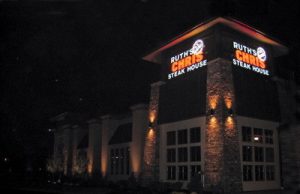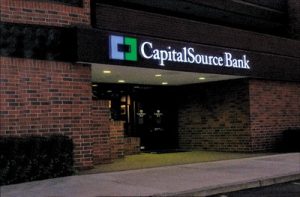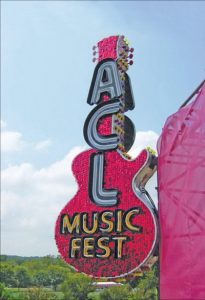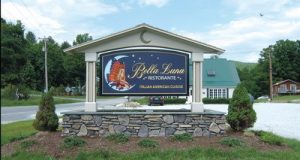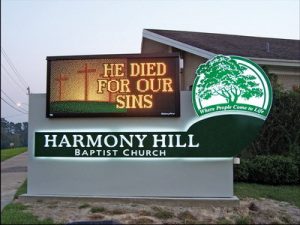Business Management
Buy-ology 101
Sign buyers reward basic communication skills, a solid reputation and customer service with loyalty.
Published
15 years agoon
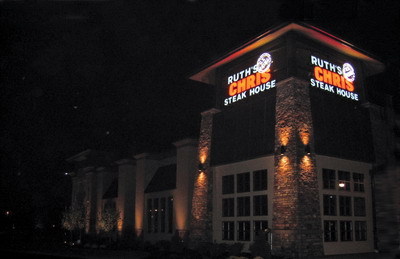
Trust is visceral – our bodies tell, and often fool, us about trustworthiness. Credibility, however, is analytical – profit margins and timelines point straightforward. Sign buyers use both tools to determine what sign company to hire.
“Reliable.” “Trouble-free.” “Takes the extra step.” “Highly referred.” “Keeps me informed.” Sign buyers interviewed for this article emphasized the importance of these trust-building characteristics when they select sign companies for various projects, from music festivals to bank changeovers. Having demonstrated outstanding emotional intelligence, however, the sign companies that buyers repeatedly hire also show price consciousness; competitive bids they submit reflect the client’s budget and realistic project assessments.
Be forewarned: The following sign buyers waxed profoundly positive about signage and the sign companies they hired. In other words, no disgruntled sign buyers participated. That’s partly because ST questioned end users whose signage was either entered in the International Sign Contest or represented a win-win situation for all parties involved. Also, they realize signage’s importance to their branding and advertising.
“Signage is a great asset in advertising our brand,” said Mark Gordon, CapitalSource Bank’s VP of corporate real estate, who recently oversaw a 22-location changeover. “Our signage is a sign of strength, and it helps define our identity in that location.”
Ruth’s Chris Steak House
“I look for somebody who doesn’t just put up a logo,” said Donnie Smith, a project consultant/purchaser for Ruth’s Chris Steak House’s Indiana and St. Louis franchisees. “I want somebody who works closely with me so the signage is suitable for the market. I also want the sign company to handle all details during every stage of the project, from concept to completion. Therefore, I look for somebody who has integrity, who’s highly referred, who’s good at customer service and who will also offer a competitive bid.”
AdvertisementWhen the upscale chain’s Mishawaka, IN site needed new signage, Smith turned to Integrated Sign Associates (ISA), El Cajon, CA, a visual-display company that provides on-premise signage for real-estate and retail clients. The project required hanging the corporate logo on a wire frame in an exposed opening of a tower, which precluded the usual reverse channel letters.
Even though Smith has often worked with the sign company for the past six years, he has met Aaron Clippinger, ISA’s president and owner, face to face only once. Clippinger has proven his trustworthiness by making decisions aligned with his client’s vision. He knows the client’s goals upfront and confirms alignment through sketches and increasingly detailed proposals.
“I know what I’m going to get,” Smith said. “I trust his judgment.”
Clippinger tells each client the basic ways signs function:
1. They advertise your business.
Advertisement2. They help customers find your location.
3. They serve as direction finders at the front door.
4. They set the mood for clients as they walk through the door.
Clippinger then asks what function(s) the proposed sign should primarily serve. This helps clarify the client’s vision. A corporate client’s signage generally combines a brand with a mood. He also said sign buyers should look for sign companies with a proven background so they can insure their work; have a contractor’s license; and belong to sign-related (national, regional and local) associations so they keep abreast of regulations.
Having worked with Ruth’s Chris for years, Clippinger knows the usual sign budget and the required materials. “We used to go through five or six rounds of proposals earlier,” Smith said, “but now we only need one or two.”
The location entailed face-lit channel letters, which meant matching the corporate colors with different lighting. Clippinger selected AgiLight Inc. SideWinder LEDs to prevent grey tones. Also, to render the face white at night, but black during the day, he used 3M black, perforated vinyl.
AdvertisementSmith cited another job in which Integrated “went beyond the usual level of work and customer service.” Recently, Ruth’s Chris wanted a blade sign for a St. Louis restaurant in the Hyatt Hotel, which sits next to Interstate 70, that needed to attract motorists’ attention. Although city zoning prohibited one, Clippinger secured a variance by documenting how signage doesn’t cause accidents.
CapitalSource Bank
CapitalSource Inc., a commercial lender, provides financial products, and its subsidiary, CapitalSource Bank, provides depository products to southern and central California. CapitalSource recently assumed a retail bank’s 22 locations and needed to rebrand them.
“In this economy,” Mark Gordon said, “we wanted to convey the bank’s financial strength and that it would continue to forge ahead with integrity.”
Having worked with ISA for six years, Gordon again turned to it for individual, facelit channel letters that appeared more vibrant than the existing, halo-lit version.
Some cities changed their sign ordinances after the previous company’s signs were placed in the building. ISA worked with landlords to understand their viewpoints, which helped to resolve some issues by, for example, reducing square footage or relocating the sign, and obtained variances when needed. Gordon said, “ISA exceeded the timeline in most cases. Aaron drove the entire process.”
Even though he’s an experienced sign buyer, Gordon encountered instances in which Clippinger showed him the advantages of one signage type over another. Also, his experience allows him to “do a gut check” regarding the prices proposed by sign companies.
Gordon said, “Our signage is an important element of our identity. I want to have a certain level of comfort in dealing with a sign company, and Aaron provides that. He’s obtained city approval in a week for some locations, when it often takes much longer.”
Austin City Limits Music Festival
The Austin City Limits (ACL) Music Festival, an annual, three-day music and art festival in Austin, TX’s Zilker Park, brings together more than a hundred bands on eight stages, and attracts a crowd of roughly 65,000 visitors daily. The festival has proved so successful that the PBS concert series (for which the festival was named) has changed from an all-Texas spotlight to resemble the festival lineup, which features artists from various musical genres.
Frank Zepponi, who handles ACL’s experiential design and marketing through his company, Deluxe Creative (Austin), establishes the brand’s look, form and feel in regards to viral and experiential marketing, culture-building campaigns, logos, POS, site-enhancements, signage, ad campaigns and promotional materials.
Depending on the design and application, Zepponi first looks locally for the appropriate signshop. He first checks with other designers and signshops for referrals.
For a 3-D guitar to be displayed on the festival portal, Zepponi checked with five sign companies before he met an artist who had worked for Ion Art, who suggested he contact the Austin-based company.
“I tend to keep fabrication local so there is sufficient, firsthand creative and material dialogue between myself and the shop that actually builds the piece,” Zepponi said. “I always choose by style of work first, making sure that the sign company can comfortably translate a particular design into a finished piece that mirrors the creative vision.
“Fortunately, Austin has a wide variety of fabricators to select from. Cost is most always a factor – especially when constructing for festivals – and reliability has to figure in when you’re dealing with one-off, complex designs.”
For example, the guitar piece, which comprises neon and carnival chase lighting, is installed, taken down and stored over a week’s timeframe, annually. As a result, the lighting components become damaged, and fabricators are called in to fix problems.
As a designer, Zepponi creates the overall sign design, including all logos and illustrations, and acts as a gatekeeper between client and fabricator. Once the client signs off on the design, he works closely with the sign company on design details, “because the fabricators are usually abreast of new techniques and materials.”
The client usually sets the budget. Zepponi said, “I like to have a working budget established before the design process begins to avoid presenting the dreaded Cadillac-on-a-Corolla budget solution.”
Local sign codes must be observed, and, when the sign is a permanent fixture, obeyed. “With festival and event signage being temporary, we can bend the rules a bit as to what’s produced and where it’s installed; we mainly concern ourselves with making sure nothing falls out of the sky and kills someone,” Zepponi said.
Zepponi appreciates the folks who “get into” their work, whether it’s bending neon, distressing surfaces or welding substructure. “With Ion Art, they made the special effort of having group meetings, including all of their artists who would be contributing to the piece,” Zepponi said. “Of course, onsite coffee and donuts is always a winner!”
However, he looks for clarity from vendors as to what they’ll deliver before any work begins. Once, a fabricator charged him to do an estimate, which he had requested, plus a rendering, which he didn’t request because he had roughed out one and emailed to them.
With festival and event signage, crowd reaction provides instant feedback on the success/value of your piece. Zepponi said, “The first year we erected the ACL guitar, we witnessed thousands of festivalgoers taking pictures of the sign and subsequently posting the photos to such social-media sites as Flickr, MySpace and YouTube. This, in turn, offers countless amounts of free, valuable, media exposure for festival producers. With permanent signage, it’s a matter of performance: Are folks seeing the sign, and are they acting? Of course, getting paid and having repeat business from your clients is the best gauge that you’ve done something right!”
Harmony Hill Baptist Church
Although the Harmony Hill Baptist Church committee ultimately agreed on the design for the main signage, the Lufkin, TX church relied on its business administrator, Jim Myers, to oversee details. Myers said the bid process took two years, during which they looked as far away as Nashville, but only two companies were asked to submit an estimate.
The church didn’t have a specific budget for a sign, but, because it needed to replace the existing, 30-year-old, changeable-letter sign, the committee dipped into money reserved for special projects. Local maintenance and communication were primary considerations. Myers said, “We wanted face-to-face contact so we could see sketches, have changes in a few days, and not have them faxed. We didn’t want a long-distance, remote, working relationship. We wanted changes and any maintenance issues handled quickly.”
Eldon Fuller, owner of Lufkin-based Ad Fab Signs, had impressed the church with his quick turnaround and customer service when he had designed and fabricated other signs for the church. When Fuller was approached with the sign proposal, he quickly delivered sketches and adjusted them to the committee’s approval.
Myers said, “We enjoyed the working relationship, but Eldon also delivered the best price.”
EMCs are currently unrestricted in Lufkin, but other areas, such as nearby Nacagdoches, mandates size, frequency and brightness. Harmony Hill didn’t want to offend neighbors with a brightly lit sign, so Fuller adjusted the brightness.
Bella Luna Restaurant
Mary Mutz, owner of the Bella Luna restaurant in Ludlow, VT, brought her extensive design background with her when she moved to the small New England town from New York City. She applied her design skills to the building she bought for her restaurant, and she wanted its signage to reflect the building’s imaginative, but tasteful, aesthetic.
Mutz selected locally based Troy Adams, owner of Signs by Troy, because he’s “the best signmaker I know of. He’s well-known and considerate, and he listened to my ideas. He allows you to have input.” Adams said. “He’s the only signshop in town, but he does get competition from shops in nearby Rutledge and Woodstock.”
Mutz wanted to ensure motorists on the nearby highway notice her sign. So, Adams fabricated this CNC-routed, 48 x 90-ft., two-sided sign, made from 18-lb., 1.5-in.-thick Sign•Foam. Details were handcarved to finish the design. The design was adapted from the logo on Mutz’s business card and ads.
Adams was interviewed in March, which is “mud season” in Vermont. During this season, when it’s almost impossible to drive back roads, much less install a sign, he focuses on vehicle graphics.

SPONSORED VIDEO
Introducing the Sign Industry Podcast
The Sign Industry Podcast is a platform for every sign person out there — from the old-timers who bent neon and hand-lettered boats to those venturing into new technologies — we want to get their stories out for everyone to hear. Come join us and listen to stories, learn tricks or techniques, and get insights of what’s to come. We are the world’s second oldest profession. The folks who started the world’s oldest profession needed a sign.
You may like

American Sign Museum Names New Executive Director

3 Things Print Pros Must Do to Build Stronger Relationships in the Interiors Market

Graphics Turn an Eyesore Cooler Into a Showpiece Promo in Historic Plaza
Subscribe

Bulletins
Get the most important news and business ideas from Signs of the Times magazine's news bulletin.
Most Popular
-

 Tip Sheet1 week ago
Tip Sheet1 week agoAlways Brand Yourself and Wear Fewer Hats — Two of April’s Sign Tips
-

 Photo Gallery2 days ago
Photo Gallery2 days ago30 Snapshots of the 2024 ISA Sign Expo
-

 Ask Signs of the Times4 days ago
Ask Signs of the Times4 days agoWhy Are Signs from Canva so Overloaded and Similar?
-

 Real Deal1 week ago
Real Deal1 week agoA Woman Sign Company Owner Confronts a Sexist Wholesaler
-

 Benchmarks6 days ago
Benchmarks6 days ago6 Sports Venue Signs Deserving a Standing Ovation
-

 Editor's Note2 weeks ago
Editor's Note2 weeks agoWhy We Still Need the Women in Signs Award
-

 Women in Signs1 week ago
Women in Signs1 week ago2024 Women in Signs: Megan Bradley
-

 Photo Gallery1 week ago
Photo Gallery1 week ago21 Larry Albright Plasma Globes, Crackle Tubes and More
